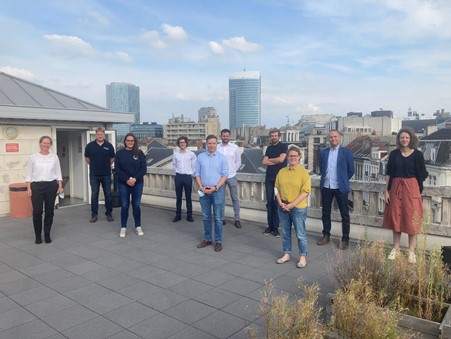In response to increasingly complex issues of civil security, Efus has been participating for a decade or so in projects aimed at raising awareness and training and representing local elected officials in order to improve local and emergency responses to major accidents, but also, more recently, daily cooperation.
The APPORT project on major catastrophes and accidents in the French-Belgian border area
Over the past ten years, civil security issues have become more complex, which requires that local elected officials have a good knowledge of the risks, whether natural, industrial, linked to transport or more broadly to human activity. Because of climate change, specific plans must be drawn out to respond to floods, droughts and seismic tremors. Industrial development creates risks in Seveso-category* industrial plants and in the transport of hazardous substances. There are also risks to people such as terrorist threats, or large events, or serious health crises such as the current Covid-19 pandemic.
A better understanding of the cross-border risks across France and Belgium
Since 2010, the European Forum for Urban Security (Efus) has been participating in a French-Belgian cross-border project titled APPORT (Aide à la Préparation des Plans Organisationnels des Risques transfrontaliers / Support to Prepare Organisational Plans for Cross-Border Risks). Initiated by the Belgian and French authorities, the project sought to better understand the risks prevailing in a common risk area sprawling beyond the administrative borders of France and Belgium, such as a major pollution or technological accident.
It was conceived in the wake of the Ghislenghien catastrophe in Belgium on 30 July 2004, which required the intervention of the French emergency response services. Indeed, several SDIS 59 and SAMU 59 emergency units were dispatched to help the Belgian emergency services deal with the consequences of a gas explosion that killed 24 people, including several firemen, and injured hundreds. Some of the wounded were sent to hospitals in France and Germany.
The APPORT project, funded by the EU as part of the Interreg 4 programme, as well as by Belgian and French authorities, was designed in response to this disaster. Nine partners worked together to analyse risks and their potential effects in case of major accident, to harmonise the cross-border aspects of their emergency plans, to test the operational needs of emergency services, and to raise awareness among local authorities and elected officials on emergency planning.
The ALARM project: towards daily mutual assistance in emergency responses
The APPORT project was focused on the management of crises and major accidents and catastrophes, whereas the new project funded by the European Union through Interreg 5 addresses a key demand of French and Belgian mayors to facilitate daily assistance for all types of event under the principle of the closest, fastest and most appropriate response. This was justified by the physical distance between Belgian and French emergency response units: depending on where an accident happens, for example a fire, a traffic accident or a river pollution, it is better to call the closest emergency response units, which can be that of the neighbouring country.
Covering a population of five million
The ALARM project envisions to use this cross-border approach for all the French and Belgian towns and cities situated near the border across a distance of 600 km. This concerns five million inhabitants, 537 French mayors, 83 Belgian mayors, 3 French prefects and 4 governors of Belgian provinces.
ALARM developed an application, GEO-ALARM, that identifies the risks prevalent in the common zones, notably floods (Yser, Escaut, and Meuse Rivers), marine submersion (North Sea), industrial risks (Seveso), chemical and technological risks (air, water and land pollution), nuclear risks (nuclear plans of Chooz and Gravelines, and Radioelement Institute of Fleurus), risks linked to rail, road and canal traffic, and terrorist threats.
The application includes all the French and Belgian Location Based emergency services that can immediately respond.
The increasingly central role of towns and cities
Within the ALARM project, Efus is leading the Axis 3 on the sensitization and empowerment of local elected officials. To this end, it organised cross-border seminars involving local elected officials and their technical team. These exchanges paved the way for the French Communal Safeguarding Plans and the Belgian Emergency and Intervention Plans to include a cross-border dimension. Furthermore, exercises were organised involving both French and Belgian teams.
In the coming weeks, ALARM will publish a guidebook that will include key legislative aspects of both France and Belgium, as well as inspiring practices and practical advice for local elected officials detailing what they need to do in case of crisis.
Adapting regulation to cross-border cooperation
Together with Belgian and French authorities, Efus drafted the Administrative Arrangement of 18 July 2019 on mutual assistance in emergency response in the French-Belgian border zone, which not only considers mutual assistance in case of catastrophe, but also daily assistance for recurring risks (fire, traffic accidents, assistance to people in distress…) and one-off events (floods, industrial accidents). The Arrangement states that common services are interoperable.
In the coming weeks, more Local Execution Protocols will be signed by the departmental Prefects and the Prefects of neighbouring Defence and Security Zones (on the French side), and the Presidents of Emergency Zones (on the Belgian side) representing the Belgian mayors and governors.
This project, which is set to be permanent, will be evaluated by a Committee on Cross-Border Cooperation (Commission d’instance de Coopération Transfrontalière) gathering the partners of the Cross-Border System for the Analysis of Risks (Schéma transfrontalier d’Analyse des Risques).
* Seveso is the name of a town situated north of Milan where a major accident took place in a chemical plant in 1976. Following the disaster, the European Union adopted a series of directives titled “Seveso” whereby industrial sites deemed at risk are to be listed and required to put in place strict prevention measures.
> More information on the ALARM project
> The European Union’s Interreg programme





